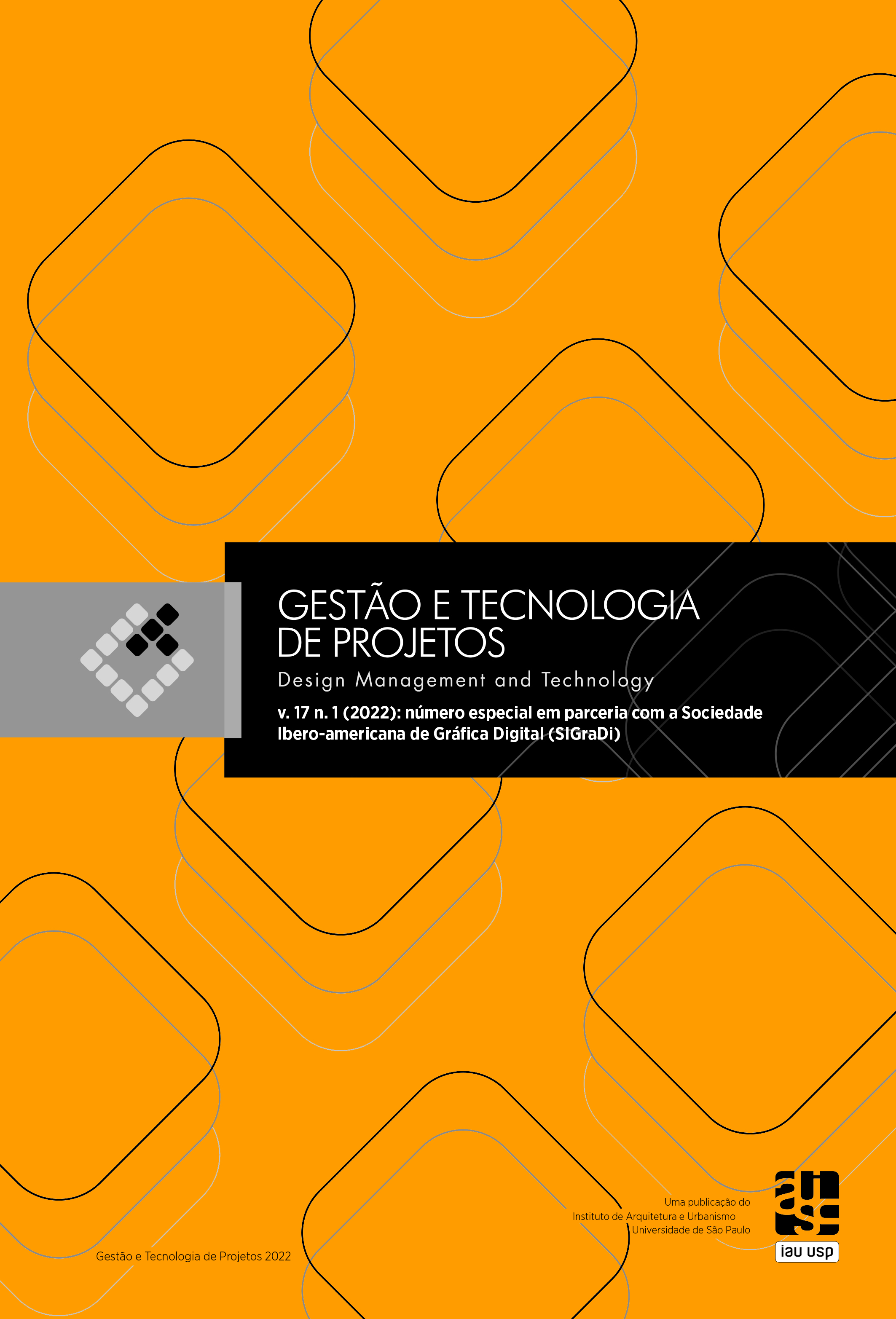Exploring bio-parametric solution-based design process for an ephemeral pavilion
DOI:
https://doi.org/10.11606/gtp.v17i1.183658Keywords:
Bio-inspired architecture, Sartorius muscle, Serpentine gallery, Parametric pavilionAbstract
This research proposes an experimental design approach to design an ephemeral pavilion located at the Serpentine Gallery in London. The Serpentine Pavilions Programme functions as an experimentation laboratory and, at the same time, public and event spaces, enabling architects to expose their projects and work methodologies. Thus, the methods of Biomimicry and Parametric Design were combined to develop the pavilion. While the first one was used to create an ephemeral pavilion based on the Sartorius muscle, the second was responsible for generating the parametric model from a fast and intuitive manipulation code capable of exploring shape variations. This work explores the solution-based method approached by Badarnah (2012) based on a predefined problem (the pavilion project) and only after that seek some natural inspiration. Firstly, it was investigated the anatomy of the Sartorius muscle. Subsequently, with the domain of the solution, the parametric insertion of the shape was computationally performed. The anatomical study of the sartorius muscle revealed functions such as flexion, abduction, lateral rotation of the thigh, and medial rotation of the knee. Thus, the architectural choices reflect both its narrow and elongated morphology of the muscle and flexibility and rotation aspects. The pavilion also considered the previous Serpentine Pavilions regarding attributes such as area, height, and materials, which with other parameters may be changed using the code implemented in Grasshopper.
Downloads
References
ASSOCIAÇÃO BRASILEIRA DOS ESCRITÓRIOS DE ARQUITETURA. Boas Práticas em BIM: Estruturação do Escritório de Projeto para a Implantação do BIM. Guia AsBEA. Fascículo I. São Paulo. Retrieved from: http://www.asbea.org.br/userfiles/manuais/a607fdeb79ab9ee636cd938e0243b012.pdf. Access: Oct. 1, 2020.
BADARNAH, L. Towards the LIVING envelope: Biomimicry for building envelope adaptation. Delft University of Technology, 2012.
BAHRAMI, A. Heteroptera. 2017. Retrieved from https://grasshopper3d.com/group/heteroptera?override. Access: Aug. 7, 2020.
BENYUS, Janine M. Biomimicry: Innovation inspired by nature. New York: Harper Perennial, 2006.
BROD, Gustavo Alcantara; SILVA, Adriane Borda Almeida da; PIRES, Janice de Freitas. Um ensaio para inserção do conceito de processos generativos digitais em estágios iniciais da formação em arquitetura. 2012.
DINO, Ipek Gürsel. Creative design exploration by parametric generative systems in architecture. METU Journal of Faculty of Architecture, v. 29, n. 1, p. 207-224, 2012.
DZIEDZIC, D.; BOGACKA, U.; CISZEK, B. Anatomy of sartorius muscle. Folia morphologica, v. 73, n. 3, p. 359-362, 2014.
EUMIESAWARD. Serpentine Gallery Pavilion 2005 (dismantled). 2005. Retrieved from https://www.miesarch.com/work/1187. Access: Jul. 14, 2020.
FISCHER, Thomas; HERR, Christiane M. Teaching generative design. In: Proceedings of the 4th International Generative Art Conference, Generative Design Lab DIAP, Politecnico di Milano 2001.
FOOD4RHINO. Pufferfish. 2020. Retrieved from https://www.food4rhino.com/app/pufferfish. Access: Feb. 8, 2021.
Google Earth website. Retrieved from: google.com.br/maps. Access: Feb. 9, 2021.
GRAY, Henry. Anatomy of the human body. Philadelphia: Lea & Febiger, 1918.
ISTOCK. Sartorius Muscle – Anatomy Muscles isolated on white. 2016. Retrieved from https://www.istockphoto.com/br/foto/sart%C3%B3rio-m%C3%BAsculos-anatomia-muscular-isolado-no-branco-gm533846530-94583675. Access: Mar. 30, 2020.
LIGHT, R.; LIN, V.; GOSSARD, D. C. Variational geometry in CAD. Computer Graphics, v. 15, n. 3, p. 171-177, 1981.
MAKE BIM. O que é Design Paramétrico. 2017. Retrieved from https://www.makebim.com/2017/01/31/bim-o-que-e-design-parametrico/. Access: Feb. 2, 2021.
MEIER, M. Kangaroo Physics Simulation for Grasshopper. 2016. Retrieved from https://mkmra2.blogspot.com/2016/11/kangaroo-physics-simulation-for.html. Access: Aug. 2, 2020.
MIGLIANI, A. O que é Madeira Lamelada Colada (MLC ou Glulam)? ISSN 0719-8906. 2019. Retrieved from https://www.archdaily.com.br/br/928061/o-que-e-madeira-laminada-colada-mlc-ou-glulam. Access: Sep. 5, 2020.
MONEDERO, Javier. Parametric design: a review and some experiences. Automation in construction, v. 9, n. 4, p. 369-377, 2000.
NADIRI, P.; MAHDAVINEJAD, M.; PILECHIHA, P. Optimization of Building Façade to Control Daylight Excessiveness and View to Outside. Journal of Applied Engineering Sciences, v. 9, n. 2, p. 161-168, 2019.
OXMAN, Rivka. Theory and design in the first digital age. Design studies, v. 27, n. 3, p. 229-265, 2006.
PROVING GROUND. Lunchbox. 2019. Retrieved from https://provingground.io/tools/lunchbox/. Access: Feb. 8, 2021.
RADWAN, Gehan AN; OSAMA, Nouran. Biomimicry, an approach, for energy effecient building skin design. Procedia Environmental Sciences, v. 34, p. 178-189, 2016.
RAO, Rajshekhar. Biomimicry in architecture. International Journal of Advanced Research in Civil, Structural, Environmental and Infrastructure Engineering and Developing, v. 1, n. 3, p. 101-107, 2014.
SOARES, Theska; ARRUDA, Amilton José. ECOMATERIAIS BIOMIMÉTICOS, UM CAMINHO EFICIENTE PARA A SUSTENTABILIDADE. MIX Sustentável, v. 3, n. 4, p. 29-45, 2017.
TEDESCHI, Arturo. AAD, Algorithms-aided design: parametric strategies using Grasshopper. Le penseur publisher, 2014.
TEER, M. New to the human plug-in? 2016. Retrieved from https://blackspectacles.com/blog/post/extra-features-in-human-free-tutorial. Access: Aug. 2, 2020.
TUNCBILEK, G. Temporary Architecture: The Serpentine Gallery Pavilions. 2013. Master Thesis. Turkey: Middle East Technical University.
VATTAM, Swaroop; HELMS, Michael E.; GOEL, Ashok K. Biologically inspired innovation in engineering design: a cognitive study. Georgia Institute of Technology, 2007.
WOODBURY, Robert et al. Elements of parametric design. Routledge, NY. 2010.
Downloads
Published
Issue
Section
License
Copyright (c) 2021 Elton Cristovão da Silva Lima, Cristina Matsunaga, Leticia Teixeira Mendes

This work is licensed under a Creative Commons Attribution-NonCommercial-NoDerivatives 4.0 International License.
Copyright Notice
Authors who publish in this journal agree to the following terms:
- Authors retain the copyright and grant the journal the right of first publication, with the article simultaneously licensed under the Creative Commons Attribution License BY NC ND, which allows the sharing of article with acknowledgment of authorship and initial publication in this journal.
- Authors are authorized to take additional contracts separately, for non-exclusive distribution of version of the article published in this journal (e.g. publish in institutional repository or as a book chapter), with acknowledgment of authorship and initial publication in this journal.
- Authors are allowed and encouraged to publish and distribute their research work online (e.g. in institutional repositories or on their personal page) at any point before or during the editorial process, as this can generate productive changes, as well as increase the impact and the citation of published article (See O Efeito do Acesso Livre).



